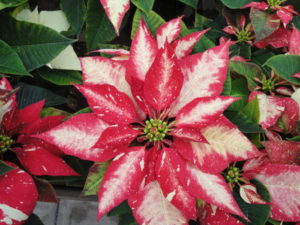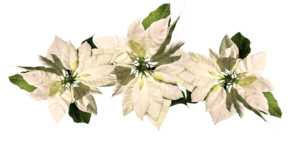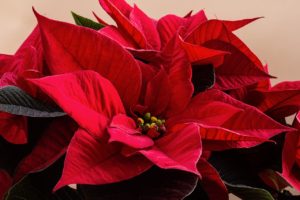Page 2
How To Care For Poinsettias
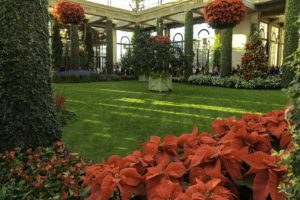
- Choose a good plant: Look for healthy foliage all or most of the way down to the soil. Avoid plants with yellow or detached brown leaves. Plants with cyathia (the true flowers in the center of the bracts) that are small or still closed are good choices. Don’t buy a wilted plant. What appear to be full, tall plants in plastic sleeves could end up falling apart when unsleeved. For the best quality, buy plants that are not kept in sleeves.
- Protect: Proper care begins before you leave the garden center. Shield the plants from blasts of cold or wind on your way to the car. It doesn’t take long before the plants show symptoms of exposure. And don’t leave them in the trunk or in the car while you “pick up a few things”! They will look sad and wilted by the time you return.
- Sleeved: Poinsettias transport well when they are sleeved only for the ride, but remove the covering as soon as you return home. Tear or cut the sleeves carefully. Poinsettia stems are very brittle and will break from the main stem with hardly any encouragement! Ethylene gas can build up if plants remain sleeved for a long period of time.
- Ethylene gas: Keep fruit bowls away from poinsettias. Ripening fruit gives off ethylene gas, a plant hormone, which can cause leaves or bracts to drop. Remove yellow leaves from the plant, and all fallen leaves as well; they, themselves, give off ethylene, exacerbating the problem. Any products of combustion, such as from a gas stove or smoke wafting in from the fireplace, can also cause damage.
- Support: Many growers use green plastic rings around the plants to help support the branches. If you need to, carefully tie green twine around the plant and some bamboo stakes to hold the stems in place.
Growing Conditions
- Light: Indoors, give your blooming plant bright indirect light, filtered sun, or gentle sun in the morning. Low light will cause a gradual decline, with lower leaves turning yellow. Bracts that have not fully expanded will emerge pale in color in low light.
- Temperature: Poinsettias next to the fireplace look lovely, but move them if you plan to have a fire. Avoid all extremes of temperature—not too hot, not too cold, and not breezy, either hot or cold. Avoid placing them near registers or a frequently used door. Temperatures in the mid to high 60’s F in the daytime, and a few degrees lower at night, is ideal.
- Water: Water your plants thoroughly and often enough to keep the soil damp, but not wet. Use room temperature, or slightly warmer, water. Never let them sit in water for more than 10 or 15 minutes. Poinsettias quickly wilt when the soil runs too dry, causing lower leaves to turn yellow and drop off.
- Fertilizer: Some gardeners welcome the challenge of keeping poinsettias and re-blooming them the next winter. If you don’t plan to discard them after the holidays, fertilize plants monthly while they’re indoors to maintain their health. Use a balanced soluble fertilizer at only 1/2 strength, starting in late January or February. Poinsettias will need more frequent fertilizing outdoors in the summer. Check the label to make sure the product has calcium.
Outdoors For the Summer
- Cutting back: In mid spring, cut the plants down to 6″. Do this on a day when the soil has begun to run a bit dry instead of when you’ve just watered them. Yes, this could mean there will be no leaves! A healthy plant will recover.
- Light: Once outdoor temperatures are above 55° at night, move your poinsettias outside to a porch or a patio, in a location with good direct sun. In hot climates, shade poinsettias in the afternoon.
- Water: As the plants regrow from buds in the stems, they will need more frequent watering. A full plant in warm sun might need watering more than once a day. Now fertilize with full strength fertilizer every other week. Poinsettias usually grow like weeds.
- Repot: Most plants growing in 4″ to 6″ pots will need to be transplanted into larger pots. The new pot should be only 2″ larger than the old one, unless the plant is especially vigorous. Don’t bury the stem lower in the soil. Use potting soil that includes peat moss.
- Cut again: For well-branched plants that later will have many bracts, prune the plants again in late June and late July. Each stem should have 3 or 4 leaves remaining, but don’t cut it back after early August.
And Back Indoors Again
- A chill in the air: Bring the plants back indoors when nighttime temperatures fall into the 50’s F. Indoors, keep them in the 60’s, and a few degrees lower at night.
- Light: Give the poinsettias at least 6 hours of direct sun indoors each day for continued growth.
- Water: Water enough to keep the soil damp. Never let it dry out.
- Fertilizer: Continue fertilizing every 2 weeks, if the plant is getting good sun. If it’s less than ideal, fertilize every 3 weeks.
- Total darkness: Through the months of October, November, and possibly into early December, place the poinsettias in a dark closet or in a spare room at night. There should be no light seeping in under the door. It must be total darkness for 14 hours per day, so a streetlight shining into the room will prevent or delay the “bloom”.
- Into the light: Don’t forget to bring the plant out from the closet every day, and into the sun. Some of the newer varieties of poinsettias are less fussy about this dark night/sunny day requirement. Most poinsettias will color up on their own in mid to late winter. But, if you want color for the holidays, this is what you need to do. Some online sources claim that only 5 days of this regimen will result in bracts, but I don’t think that will do it. They need the full 8 to 10 weeks. Toward the end of this period, you’ll probably notice color developing in the younger leaves.
National Poinsettia Day
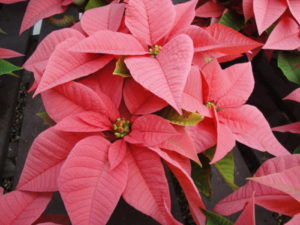
In 2002, HR 471, sponsored by Representative Randall Cunningham (R-CA) passed, declaring December 12 National Poinsettia Day. Cosigners of the bill: Susan Davis (D-CA), Bob Filner (D-CA), Duncan Hunter (R-CA), Darrell Issa (R-CA), and Doug Ose (R-CA).
I hope you have a wonderful Christmas. Now, add some poinsettias, amaryllis, cyclamen, and paperwhites to make it merry and bright!
Headings
Page 1: Poinsettias in December, History of Poinsettias, The Christmas Connection, Modern Culture of Poinsettias, Varieties, and Variegated Bracts and Foliage
Page 2: How To Care For Poinsettias (Growing Conditions), Outdoors For the Summer, And Back Indoors Again, and National Poinsettia Day
Pages: 1 2
